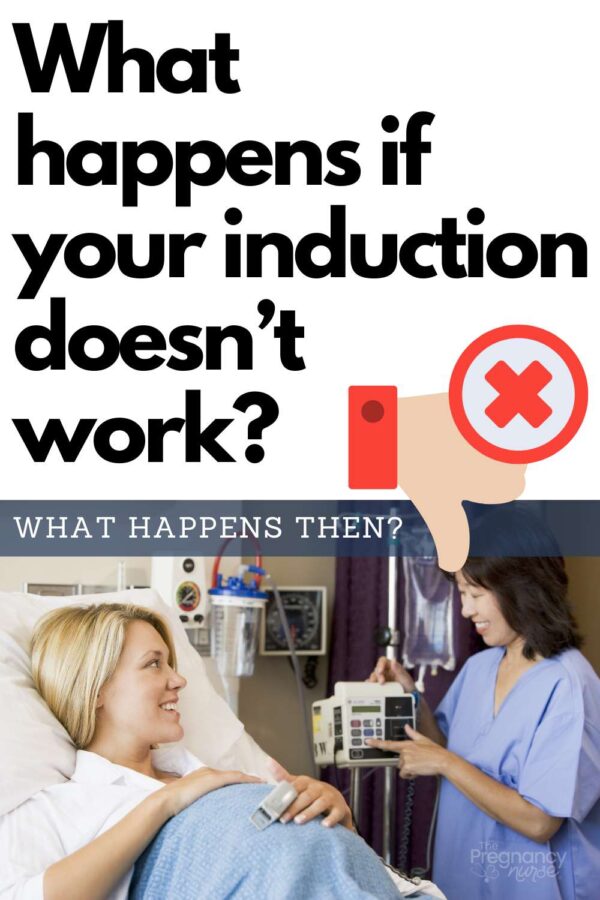📣 YOU are clearly getting prepared for pregnancy, birth & beyond — but do you wish your partner was more involved (looking for a teammate rather than just a cheerleader)? Couples love THIS! 💛🧡💚
You’re going in for an induction, but in the back of your head — you’re sort of wondering what happens if it doesn’t work? Great question — today I’m going to share the 3 paths an induction can take so you’re prepared!
Before we get going, be sure to grab my induction checklist. Having an idea of what to expect before you go is SO important. Grab this for sure:
Before we get going, let’s talk about a couple of things about it “not working” (because you may not know what that means)….

Why would an induction not work?
Great question — and one we should answer before we get going. They normally “don’t work” for a few reasons:
- Your body won’t respond to the medication (fairly rare — most people at least contract)
- Your body is SURE it is not time to have the baby and won’t let your cervix dilate
- Either your pelvis or baby’s position is keeping baby from descending into the birth canal
Want to learn more about inductions, check out these posts:
- Your Myth-Busting Guide to Induction
- How To Prepare For An Induction
- Navigating Induction: Empowering Choice and Educating Yourself with Dr Elizabeth
- 6 Things To Know About Your Fetal Growth Ultrasound
- Why You Might Want an Induction with Juli Pyle CNM
How can we tell an induction isn’t working?
Most often you’re having strong contractions but it isn’t moving baby into the birth canal, or opening your cervix.
We may place something called an IUPC that measures the strength of the contractions — see if they’re “adequate” (it’s sort of hard to tell otherwise). This is the most scientific way to measure the contractions.
I bet some of you are thinking this seems complicated, and let me say YES — labor CAN feel quite complicated, but having an expert with you makes it SO much easier. Get prepared!
SO, what happens if it’s not working?
There are 3 paths if we feel like it’s not working (or not working fast enough):
- Have a C-section
- Send you home
- Try the induction longer, or take a break (for a few hours) and try again.
Things we consider when deciding:
- Reason you’re being induced (if baby needs to come out we can’t send you home)
- What products we’ve tried (can we try something else?)
- Your preferences

Ok, let’s talk about those 3 more in depth:
Have a C-Section
If baby needs to come out and no amount or type of medication seems to be doing anything, you may have to have a cesarean section.
This most often happens when we don’t think that waiting (aka, sending you home) is good for you or baby. Perhaps baby is big, you have high blood pressure or a variety of reasons we decide it’s safer to have a C-section than to continue to labor.
While this, normally, isn’t an EMERGENCY c-section, it often happens quickly once the decision is made.
Not having some basic preparation about a C-section is one of the biggest mistakes couples make before birth, and I hear their regret all the time. Get prepared here!
Send you home?
Maybe your body just isn’t ready for this. If you are choosing to have an elective induction and the medications aren’t working — let’s send you home for a few days, and maybe try again.
People hate this one (most of them). But I think it’s a really viable plan. Better than trying to force baby more or a C-section if baby and you are doing well.
Often, patients beg to just have a C-section rather than go home, but I really think you should consider going home if everyone thinks it’s safe. AND, you should know it may end up happening if labor doesn’t get going.
BTW while we’re here — have you worked on your birth plan yet — let me help you out:
Continue Induction
We can just keep trying the induction. We could switch medications, we could break your water, we could try a variety of things.
Most often we choose this if you need to have the baby, but baby and you are both tolerating labor well.
We may encourage you to get an epidural if you have been dilating but have stopped — it might help you relax and sleep, to allow your cervix to open.
Want to learn more about pain management in labor — check out these posts:
- How Many CM Do You Need To Be To Get An Epidural?
- Weird Side Effects From The Epidural That No One Talks About
- What To Do If You Can’t Decide If You Want An Epidural Or Not?
- Pain Management Options in Labor?
- Does an Epidural for Labor Completely Take Away The Pain?
Prior to this…
Of course, if you’re not progressing there can be other signs that this needs to be done. Baby’s heart rate may show some signs of distress (limitless contractions aren’t what babies are made for), you may start to bleed or possibly even get a temperature — so baby’s progress isn’t ALL that we follow….
Also, WAY prior to this you need to ask those questions:
SO many people come in for an induction because they’re “done” being pregnant, only to realize that they’re looking at 24+ hours of labor on a closed/thick/high cervix.
Franky, I’m here to support whatever you want to choose after 39 weeks of labor but I REALLY want you to be informed on what to expect, so be sure to go through those questions with your provider.
I can’t tell you how often your expectations (often not based on reality, just a few birth stories) are ruining your birth.
This is true of inductions, but also other types of labor as well! That’s why I created The Online Prenatal Class for Couples — it’s going to give you realistic expectations of what to expect and what types of choices you’ll confront as you’re in labor.
No more “no one told me….” because YOU have learned from an expert!
Want to do a vibe check before diving into the whole thing with me? — check out my free labor pro tips. It’s your first step toward getting in the driver’s seat of your birth.











 C-Section Recovery: Tips You’ll Need
C-Section Recovery: Tips You’ll Need
